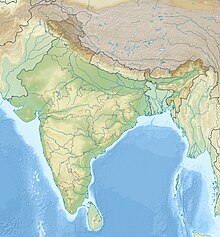Kollur Mine
Kollur Mine was a series of gravel-clay pits on the south bank of the Krishna River in the state of Andhra Pradesh, India.[1] It is thought to have produced many large diamonds, known as Golconda diamonds, several of which are or have been a part of crown jewels.
The mine was established in the 16th century and operated until the 19th century.
History
[edit]Kollur Mine operated between the 16th and mid-19th centuries,[2] and was one of the largest and most productive diamond mines on the Indian subcontinent. At the height of production, around 30,000 – 60,000 people worked there, including men, women, and children of all ages.[3] Kollur itself had a population of around 100,000.[4]
Golconda mines were owned by the king, but operation was leased to diamond merchants, either foreigners or Indians of the goldsmith caste. As well as rent, the king also received 2% from sales and he was entitled to keep all diamonds weighing over 10 carats.[5]
Mining at Kollur was crude, labour-intensive, and dangerous. Miners wore loincloths, slept in huts covered with straw, and were often given food instead of money for wages. The pit walls had no timber supports and caved in after heavy rains, killing dozens of men at a time (women and children worked above ground).[6]
The area was evacuated in the 2000s to make way for the Pulichinthala irrigation project and is submerged by 50 feet (15 m) of water for most of the year.[7]
Geology
[edit]The gravel-clay pits were a maximum depth of 4 metres (13 ft) due to the high water table.[1] The diamond-bearing seam was approximately 1 foot (30 cm) thick.[8] Alluvial workings covered an area 1.5 kilometres (0.93 mi) long and between 500 metres (0.31 mi) and 800 metres (0.50 mi) wide.[9] It was bounded to the east by an outcrop of the Nallamala Hills and to the north and west by a meander of the Krishna River.[10] Most of the pits have since been filled up with scree, boulders, and eluvium from neighbouring hillsides.[9]
Notable finds
[edit]The Tavernier Blue diamond was purchased by Jean-Baptiste Tavernier from the Kollur Mine in the mid-17th century.[11] King Louis XIV of France bought the diamond from Tavernier, but it was stolen during the French Revolution; it reappeared and has been re-cut as the Hope Diamond.[12] Other diamonds thought to have originated at Kollur include the Koh-i-Noor,[1] the Great Mogul,[13] the Wittelsbach-Graff,[14] the Regent, the Daria-i-Noor, the Orlov, the Nizam, the Dresden Green, and the Nassak.[citation needed]
Location and maps
[edit]Kollur Mine's location on the south bank of the Krishna River is indicated at latitude 16° 42' 30" N and longitude 80° 5' E on several maps created in the 17th and 18th centuries.[15]
All memory of its position was lost, until it was rediscovered in the 1880s by Valentine Ball, a geologist who helped to create this map of Golconda mines.[16] In his annotated English edition of gem merchant Jean-Baptiste Tavernier's book Travels in India (1676), Ball notes that ruins of houses and mine workings could still be found at Kollur.[17]
In the 1960s, Kollur Mine was pinpointed more accurately as being 1.5 kilometres (0.93 mi) due north-east of Kollur village[a] on the south bank of River Krishna at latitude 16° 43' N and longitude 80° 02' E, and extending for 1.5 kilometres (0.93 mi) all the way up to Pulichinthala village.[9]
-
Golconda diamond mines map (left) with locations of mines
-
Golconda diamond mines map (right) with map key
-
1904 map of diamond fields in India
See also
[edit]Notes
[edit]- ^ Not to be confused with Kollur, Guntur district.[10]
References
[edit]- ^ a b c T. K. Kurien (1980). Geology and Mineral Resources of Andhra Pradesh. Geological Survey of India.
- ^ Ralf Tappert; Michelle C. Tappert (2011). Diamonds in Nature: A Guide to Rough Diamonds. Springer Science & Business Media. p. 55. ISBN 978-3-642-12572-0.
- ^ Stephen Howarth (1980). The Koh-i-Noor Diamond: The History and the Legend. Quartet Books. p. 60. ISBN 978-0-7043-2215-8.
- ^ Arun Kumar Biswas; Sulekha Biswas (2001). Minerals and Metals in Ancient India. D.K. Printworld. p. 25. ISBN 978-81-246-0183-9.
- ^ Karin Hofmeester; Bernd-Stefan Grewe (2016). Luxury in Global Perspective: Objects and Practices, 1600–2000. Cambridge University Press. pp. 59–60. ISBN 978-1-107-10832-5.
- ^ Karin Hofmeester (2012). Marcel van der Linden; Leo Lucassen (eds.). Working on Labor. Brill. pp. 26–28. ISBN 978-90-04-23144-3.
- ^ Appaji Reddem (22 April 2017). "In the quest of yet another Koh-i-noor". The Hindu. Archived from the original on 12 November 2020. Retrieved 30 November 2017.
- ^ Philip Scalisi; David Cook (1983). Classic Mineral Localities of the World: Asia and Australia. Van Nostrand Reinhold Co. p. 54. ISBN 978-0-442-28685-9.
- ^ a b c Geological Survey of India (1971). Diamond: A Collection of Papers. Manager of Publications. p. 177.
- ^ a b Journal of Indian History. Vol. 9. University of Kerala. 1931. pp. 362–63.
- ^ Jean-Baptiste Tavernier (2012). Travels in India. Cambridge University Press.
- ^ National Museum of Natural History. "The History of the Hope Diamond". Smithsonian Institution. Archived from the original on 9 March 2013.
- ^ Howarth, p. 62.
- ^ Matthias Schulz (25 January 2010). "Schleifstein der Schande" (in German). Der Spiegel. Archived from the original on 2 February 2010. Retrieved 30 January 2010.
- ^ Jean-Baptiste Tavernier (1889). Valentine Ball (ed.). Travels in India. Vol. 1. Macmillan. p. 172.
- ^ Richard Kurin (2017). Hope Diamond: The Legendary History of a Cursed Gem. Smithsonian Institution. p. 42. ISBN 978-1-58834-419-9.
- ^ Jean-Baptiste Tavernier (1889). Valentine Ball (ed.). Travels in India. Vol. 2. Macmillan. p. 73.
External links
[edit]![]() Media related to Kollur Mine at Wikimedia Commons
Media related to Kollur Mine at Wikimedia Commons




